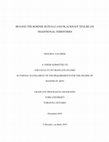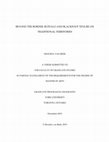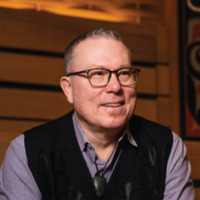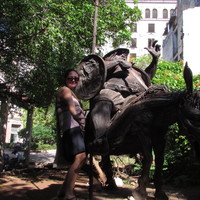Papers by Shoukia van Beek

York University, Aug 11, 2020
The international US-Canada border divides and dissects the ancestral territory of the Siksikaits... more The international US-Canada border divides and dissects the ancestral territory of the Siksikaitsitapi Indigenous nations. This thesis examines Siksikaitsitapi experiences of the border as a settler-colonial method of containment and their resistance to these processes through the reintroduction of the buffalo. The reintroduction of the buffalo to Siksikaitsitapi territory represents Siksikaitsitapi worldviews and relationship to the lands which extend across and beyond the imposed border. The buffalo are powerful within Siksikaitsitapi ways of knowing, and their return signifies a resilience in a host of sacred, social, cultural, and traditional principles that underpin Siksikaitsitapi life. This study shows that through the cross-border movement of the free-roaming buffalo, the Siksikaitsitapi are asserting their ongoing presence, relationship to the land, and sovereignty by using Indigenous-led conservation to challenge the divisive nature of the border. This research highlights how Siksikaitsitapi thought and worldviews are continuous and offer a sustainable and meaningful practice for conservation governance. iii ACKNOWLEDGEMENT I would like to acknowledge that the land on which I learned and lived, and from where this thesis and research is rooted and belongs, is the ancestral and traditional territory of the Siksikaitsitapi, Niitsitapi, or the Blackfoot Confederacy. Today, as it has been since time immemorial, this traditional territory-the land, water, air, animals, and plants are all interconnected and hold significant meaning to the Blackfoot Confederacy. The central themes of this thesis, including sense of place, movement, ecology, relationships, community, and geography have been important to and practiced by the Siksikaitsitapi for tens of thousands of years before I began thinking or writing about them. I am forever grateful for and humbled by my time on Siksikaitsitapi lands, and from these experiences I will continue to grow, learn, and interrogate my relationships to the places and spaces I take up as a settler. I want to thank my thesis advisor Dr. Libby Lunstrum for her continuous support of my M.A. study and research, for her patience, motivation, enthusiasm, guidance, and endless knowledge. As my supervisor, she has taught me more than I could ever give her credit for here. She has shown me, by her example, who a good researcher and academic should be. I wish to express deep gratitude to my committee member: Dr. Peter Vandergeest, for his encouragement, substantial intellectual support, insightful comments, and hard questions. To my external examiner Dr. Carolyn Podruchny, for her enthusiasm, sincere engagement, and thoughtful contributions. My warm thanks also extends to Dr. Robin Roth whose many discussions, valuable suggestions, and expert advice have been invaluable throughout all stages of my work. I am grateful to all of those whom I have had the pleasure of working with during this project. To Mike Bruised Head,

The international US-Canada border divides and dissects the ancestral territory of the Siksikaits... more The international US-Canada border divides and dissects the ancestral territory of the Siksikaitsitapi Indigenous nations. This thesis examines Siksikaitsitapi experiences of the border as a settler-colonial method of containment and their resistance to these processes through the reintroduction of the buffalo. The reintroduction of the buffalo to Siksikaitsitapi territory represents Siksikaitsitapi worldviews and relationship to the lands which extend across and beyond the imposed border. The buffalo are powerful within Siksikaitsitapi ways of knowing, and their return signifies a resilience in a host of sacred, social, cultural, and traditional principles that underpin Siksikaitsitapi life. This study shows that through the cross-border movement of the free-roaming buffalo, the Siksikaitsitapi are asserting their ongoing presence, relationship to the land, and sovereignty by using Indigenous-led conservation to challenge the divisive nature of the border. This research highlights ...
FPCC, 2016
First Peoples’ Cultural Council is located on Vancouver Island, BC and provides Indigenous commun... more First Peoples’ Cultural Council is located on Vancouver Island, BC and provides Indigenous communities with support and resources for cultural heritage programming, often involving language revitalization. To support ongoing advocacy and the development of a new health related language program they are interested in exploring the ways language relates to or is an indicator of health and wellbeing. Through the University of British Columbia First Nations and Indigenous Studies Practicum program, Shoukia van Beek collected various articles, websites, news clippings and books to survey the body of knowledge regarding health and language. This is the comprehensive collection of her findings.
Drafts by Shoukia van Beek
CONFIGURATIONS OF LAW, NATURE, AND MOTHERHOOD IN COLONIAL CANADA
Conceptualizing the Commons: Spatializing Lockean Philosophical Underpinnings of Extractive Industry
Thesis Chapters by Shoukia van Beek

Beyond the Border: Buffalo and Blackfoot Tenure on Traditional Territories
York University, 2020
The international US-Canada border divides and dissects the ancestral territory of the Siksikaits... more The international US-Canada border divides and dissects the ancestral territory of the Siksikaitsitapi Indigenous nations. This thesis examines Siksikaitsitapi experiences of the border as a settler-colonial method of containment and their resistance to these processes through the reintroduction of the buffalo. The reintroduction of the buffalo to Siksikaitsitapi territory represents Siksikaitsitapi worldviews and relationship to the lands which extend across and beyond the imposed border. The buffalo are powerful within Siksikaitsitapi ways of knowing, and their return signifies a resilience in a host of sacred, social, cultural, and traditional principles that underpin Siksikaitsitapi life. This study shows that through the cross-border movement of the free-roaming buffalo, the Siksikaitsitapi are asserting their ongoing presence, relationship to the land, and sovereignty by using Indigenous-led conservation to challenge the divisive nature of the border. This research highlights how Siksikaitsitapi thought and worldviews are continuous and offer a sustainable and meaningful practice for conservation governance.











Uploads
Papers by Shoukia van Beek
Drafts by Shoukia van Beek
Thesis Chapters by Shoukia van Beek